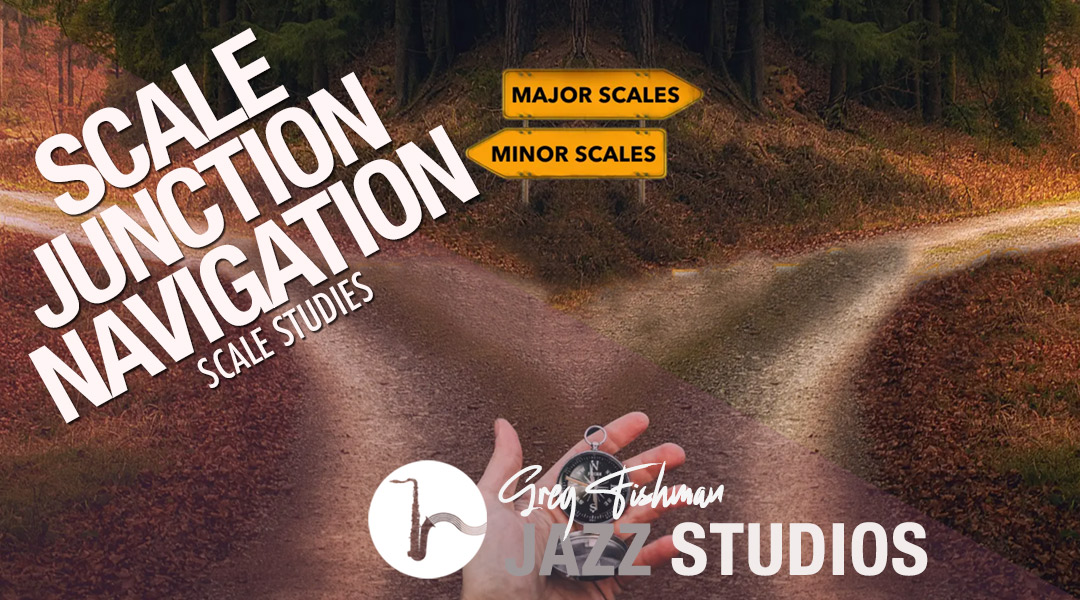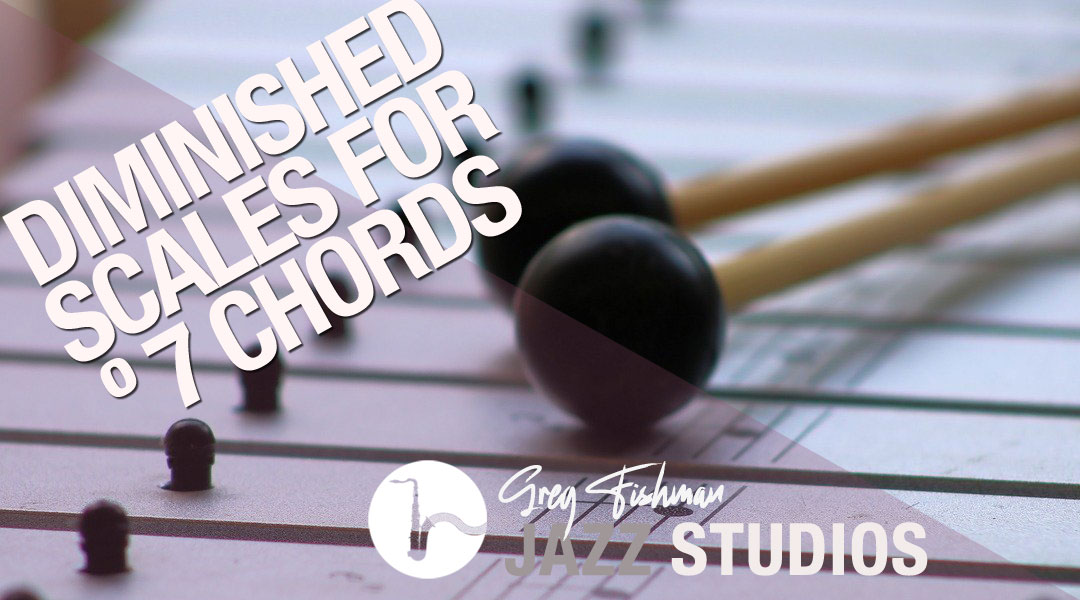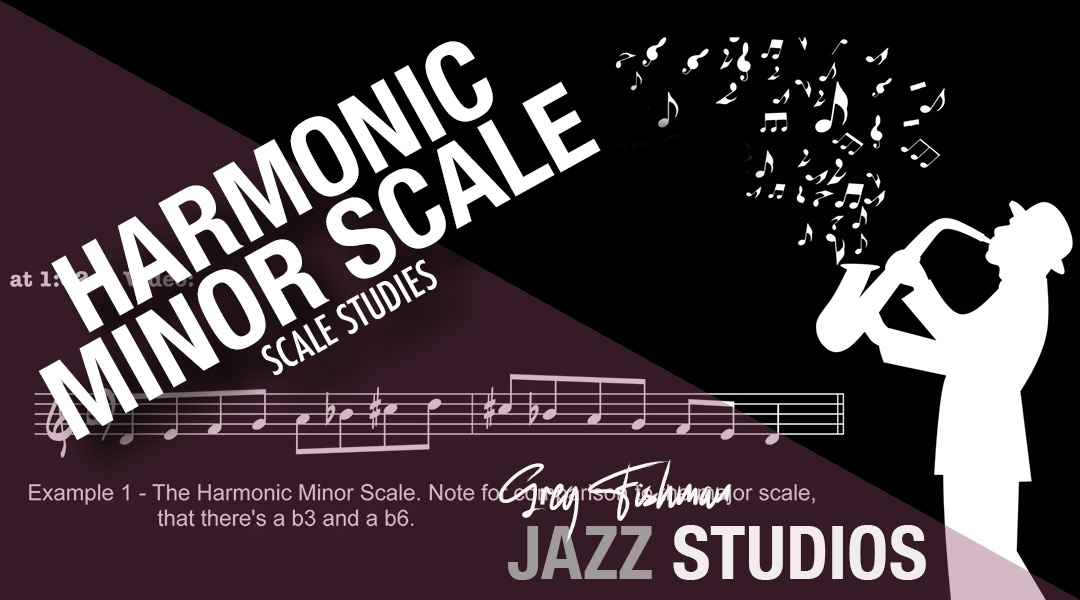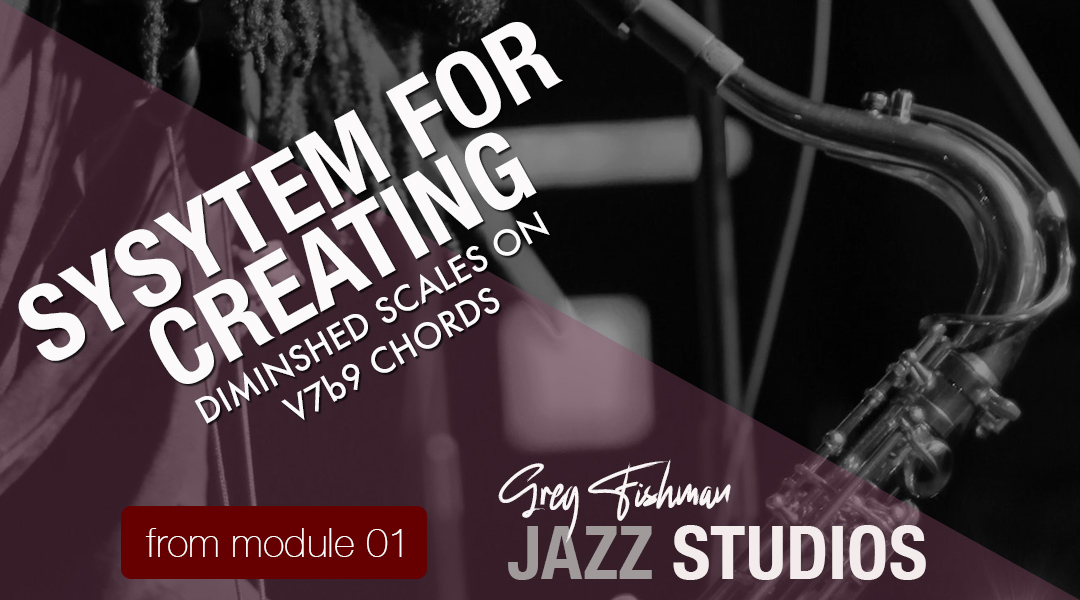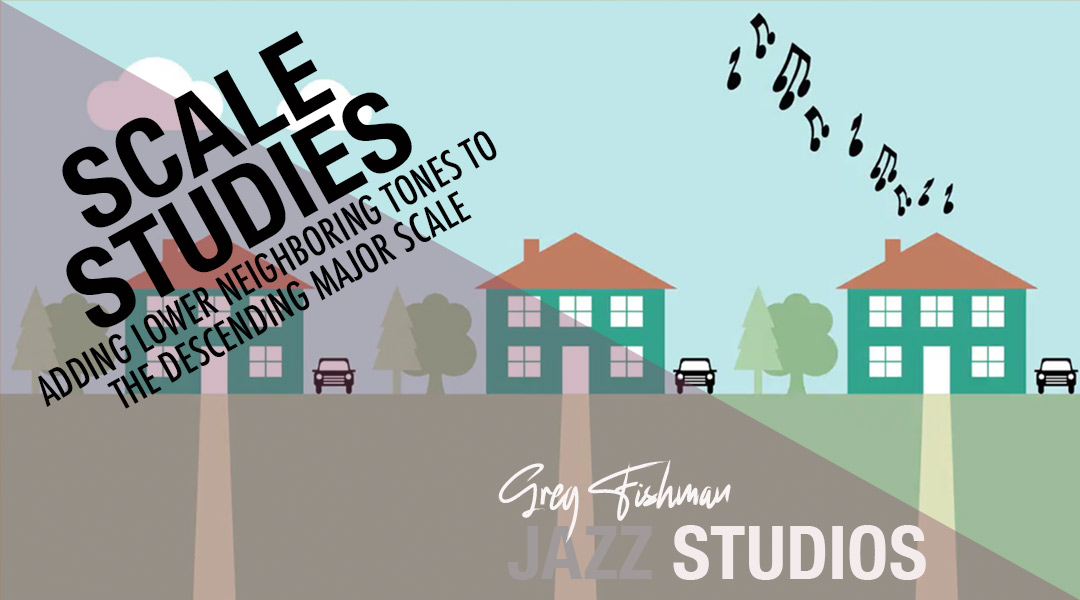Neighboring Diatonic Seventh Chord/Scale System (Parts 1, 2, 3 and 4)
The High Tide Approach to Scale Practice
The High Tide Approach to Scale Practice
The Blues Scale – Part 2 of 2
The Blues Scale – Part 2 of 2
The Blues Scale – Part 1 of 2
The Blues Scale – Part 1 of 2
Creative Scale Practice
Creative Scale Practice
Secret Applications for the Bebop Scale
Secret Applications for the Bebop Scale
Scale Junction Navigation
Scale Junction Navigation
The Diminished Scale over a Cº7 Chord – New System
The Diminished Scale over a Cº7 Chord – New System
The Jackpot 7-7-7 – Hearing a major scale over a II V I
The Jackpot 7-7-7 – Hearing a major scale over a II V I
The Harmonic Minor Scale
The Harmonic Minor Scale
System for Creating Diminished Scales on V7b9 Chords
system for Creating Diminished Scales on V7b9 Chords
Adding Lower Neighbouring Tones to the Descending Major Scale
Adding Lower Neighbouring Tones to the Descending Major Scale
Neighbouring Diatonic Seventh Chord/Scale System (Parts 1, 2, 3 and 4)
Neighboring Diatonic Seventh Chord/Scale System (Parts 1, 2, 3 and 4)
The High Tide Approach to Scale Practice
The High Tide Approach to Scale Practice
The Blues Scale – Part 2 of 2
The Blues Scale – Part 2 of 2
The Blues Scale – Part 1 of 2
The Blues Scale – Part 1 of 2
Creative Scale Practice
Creative Scale Practice
Secret Applications for the Bebop Scale
Secret Applications for the Bebop Scale
Scale Junction Navigation
Scale Junction Navigation
The Diminished Scale over a Cº7 Chord – New System
The Diminished Scale over a Cº7 Chord – New System
The Jackpot 7-7-7 – Hearing a major scale over a II V I
The Jackpot 7-7-7 – Hearing a major scale over a II V I
The Harmonic Minor Scale
The Harmonic Minor Scale
System for Creating Diminished Scales on V7b9 Chords
system for Creating Diminished Scales on V7b9 Chords
Adding Lower Neighbouring Tones to the Descending Major Scale
Adding Lower Neighbouring Tones to the Descending Major Scale
Module 54
LESSON 1: The Pivot
In this video lesson, I use Hip Lick #1 to demonstrate an essential device for creating many variations from a very small amount of musical material.
This device is commonly known as “The Pivot.” The pivot involves the use of octave displacement applied to one or more notes in a phrase. I call this concept “high mileage,” because you get so much more from each musical idea when you apply the pivot.
Sometimes the pivot is used to simply modify a phrase in order to make it fit within the range of an instrument. Other times, the pivot is used simply to the benefit of musical variety with the same group of notes in a phrase. Includes detailed PDF practice notes for Bb, Eb and C instruments.
LESSON 2: Neighboring Diatonic Seventh Chord/Scale System (Parts 1, 2, 3 and 4)
In this series of four video lessons, I share a new system that I have developed for the creation of scales. The system uses two neighboring diatonic seventh chords to create any mode of any scale.
In the first three videos, I demonstrate the system using the vibraphone, for both the visual presentation of the instrument, as well as the fact that I can let the notes ring into each other, providing a combined sound of all notes from both chords.
In part 4, I demonstrate the system on tenor saxophone.
This is a completely different approach to scale construction, and it’s fantastic for ear training, as it gives your ear an overview of the sound of the scale with the chord arpeggios.
In addition, I break down the system to groupings of four notes, six notes, and eight notes, which provides not only a graduated system for your ear to absorb the sounds but also gives you incredible fluency of technique.
Part 1: Overview and explanation of the system.
Part 2: How to practice with the system to create the major scale.
Part 3: Chord combination formulas for all modes of the major scale system.
Part 4: Demonstration of the system on tenor saxophone.
Includes detailed PDF practice notes for Bb, Eb and C instruments. Also includes PDF with chord formulas for both major and melodic minor modes.
LESSON 3: Continuous Tone – Keeping the Air Moving
In this video lesson, I share a strategy that has helped so many aspiring students struggling with playing their chords in a smooth way. Many students tend to stop blowing whenever they are unsure of the next note in a chord to play. When working with one of my skype students, this approach immediately made him sound smoother and more expressive.
Module 49
LESSON 1: Creating a melody from Three Voice Leading Lines
In this video lesson, I demonstrate how to construct a melody from three voice leading lines. This is a great way to make your playing sound both melodic and harmonically accurate.
Harmonically, this approach covers you because you’re using voice leading from three locations in each chord, leading to three new locations in the upcoming chord. Melodically, you’re covered because this approach has built-in sequencing when you switch between the three voices.
Includes PDF practice notes for Eb, Bb and C instruments.
LESSON 2: Exploring Hip Lick #3
In this video lesson, I explore Hip Lick #3 from Hip Licks for Saxophone, Volume 1. The lick highlights a iimi7 V7 chord progression, starting on the 9th of the iimi7 chord.
The video explores strategies for hearing the root movement, 7-3 voice leading and hearing how to easily locate the first note of the lick, which is the 9th of the iimi7 chord. For advanced players, I demonstrate some ways of extending the lick into a two measure
phrase. Includes PDF practice notes for Bb, Eb and C instruments.
LESSON 3: The High Tide Approach to Scale Practice
In this video lesson, I share my concept called “High Tide” for scale practice. This approach will improve your technical facility on the saxophone while also improving your musical memory.
This approach adds one new note each time you ascend the scale from the root. If you’ve been playing your scales the same-old-way for many years, this new approach will add extra freshness for your ears and your fingers.
LESSON 4: The Surfer Analogy & Thinking in Reverse
In This video lesson I share two key concepts that will help to give you smooth technique through efficiency of motion, minimizing any wasted finger movement while
playing the saxophone. In the surfer analogy, your fingers are the surfers, the keys are the surfboards and the keys moving up and down on the horn are the waves of water.
The “thinking in reverse” concept is something that i developed in my 30’s when exploring ways to improve my technical accuracy on the horn. I found that instead of thinking about the finger pressing the note being played, my technique improved if I focused on the keys not being pressed. Implementing these two concepts will greatly improve your technique on the saxophone.
LESSON 5: Road Tips – Location of Notes within Dominant 7th Chords
In this lesson, I show you how to think of one note in four different locations within a Dominant 7th chord. For example, C = Root of C7, but C = the 3rd of Ab7, C = the 5th of F7, and C = the 7th of D7. The importance of enharmonic notes is also discussed in the video. The first part of the video is at an easy pace.
At the end of the video I do a “speed round” for advanced players. This is a fun way to review and sharpen up your chord spelling skills.
Module 47
LESSON 1: Idiomatic Front F Lick
During a Skype lesson, one of my students was having trouble using his front F key on the saxophone. He couldn’t get comfortable with it. I created this lick to show him how I often access the key.
I refer to this as an “idiomatic” lick because it lays so well on the horn. This is not the only way to use the key, but it’s a good introduction to get comfortable with the unique hand position required for front F.
Includes PDF practice notes.
LESSON 2: Major Seventh Chord Inversions
In this video lesson, I play the major seventh chords in all inversions with what I call the “top margin” of my “C” on tenor, with all notes descending: C B G E (Cmaj7), C Ab G Eb (Abmaj7), C A F E (Fmaj7), and C Ab F Db (Dbmaj7).
Playing the inversions in this manner really highlights the interval structures of the chords and improves the accuracy of the ear. This is a great practice approach for ear training and improved control of your major seventh chords.
Advanced level. Includes PDF practice notes for Bb, Eb and C instruments.
LESSON 3: Getz Double Note Articulation Effect
In this video lesson, I demonstrate a specialized type of articulation that I call the “Getz Double Note Articulation Effect.”
This is a device that I first heard on an album called “Stan Getz Plays.” It gives the illusion of double-tonguing, but it’s single tonguing with very strategically placed slurs.
Learning to use this effect has really improved my control and speed for articulation. This is a great tool to have in your “special effects” bag of tricks to add something unique to your solos.
Includes PDF practice notes for Bb, Eb and C instruments.
LESSON 4: The Blues Scale – Part 1 of 2
In this video lesson, I explore the blues scale. This part one video teaches scale construction and application of the blues scale over a dominant and a minor chord.
I share my thoughts on using the scale over the full range of the horn and demonstrate some popular techniques used by the masters with this scale, including sequencing and repetition.
Includes PDF practice notes for Bb, Eb and C instruments.
LESSON 5: The Blues Scale – Part 2 of 2
This video lesson continues where part one ended, exploring options for adding extra chromatic notes to the scale.
Includes many examples in which I play some of my favorite phrases using the scale with the extra notes.
I also share my thoughts on the overuse of this scale by beginning players and explain why I look at this scale as a sort of musical spice, used to enhance the flavor of a chord progression.
Includes PDF practice notes for Bb, Eb and C instruments.
Module 44
LESSON 1: Six Essential Items for Daily Practice
In this video lesson, I discuss the importance of practicing each item on my practice planner. I developed this approach in my 20’s when I was practicing many hours each day. I experimented with many different approaches to practicing and found that these six items yielded the best results.
Many people get stuck practicing only scales or chords and never seem to get to other items like vocabulary, transcriptions, etudes, and tunes.
Includes PDF practice planner.
LESSON 2: Secret Applications for the Bebop Scale
In this video lesson, I share what I call the “secret” applications for the bebop scale. These are not the types of applications that you learn in school. In both my undergrad and graduate studies, there was no mention of these applications of the scale.
And yet, when I transcribed the masters, I found that they routinely applied the scale in this way when they wanted to get more harmonic flavor from the scale.
If you’ve ever been at a loss for how to use the bebop scale over a minor ii / V situation, this video will show you how to apply the scale like a seasoned professional.
Includes detailed PDF practice notes for Bb, Eb and C instruments.
LESSON 3: Creative Scale Practice
In this video lesson, I share a story about one of my Skype students who was very bored with his scale practice. He was in a rut, always playing his scales like a technical exercise, rather than finding the music hidden within the scales.
I showed him these creative practice strategies that I use in my own practice and he was instantly playing with more energy and creativity while also improving his musical memory and his instrumental technique.
Includes detailed PDF practice notes for Bb, Eb and C instruments.
LESSON 4: C.E.S.H. – What it is and How to Use it.
In this video lesson, I explore and explain C.E.S.H. The term was coined by one of my former teachers, the great Jerry Coker. It stands for “Contrapuntal Elaboration of Static Harmony.” Basically, it means that you apply voice leading to a chord within itself by moving the sevenths (and sometimes the fifths).
This is a common harmonic device used by all pro players. You’ll recognize it as soon as you hear it. I explain the device and break it down in a way that makes it easy for all levels of players to immediately use this in their solos. Includes detailed PDF practice notes for Bb, Eb and C instruments.
LESSON 4: Thumb Position for the Octave Key
In this video lesson, I discuss and demonstrate the importance of good thumb position on the saxophone. This topic is often overlooked. Over the years, I’ve taught many students who needed to correct bad habits with their thumb position. In some cases, students were experiencing pain from using the wrong position or from using too much pressure.
The left hand cannot operate with efficiency without an excellent thumb position, combined with a light touch. If you’ve ever had issues with left-hand technique problems or pain in your left hand or arm due to the octave key, this video will address all of those issues and provide a clear strategy to fix the problem.
Module 38
LESSON 1: Scale Junction Navigation
In this video lesson, I share my method for connecting various types of scales through a ii V I progression. This is a critical skill for all improvisers, as it gives you the flexibility to switch smoothly from the scale of the current chord to the scale for a new chord Many players are limited in their approach with scales because they think that they need to start each new scale from the root.
This is how scales are often taught in academic settings, but my system shows you how to easily connect the scales through voice-leading, from any note, highlighting the strongest notes in every chord. INTERMEDIATE & ADVANCED LEVEL. Includes detailed PDF practice notes for Bb, Eb and C instruments.
.
LESSON 2: Charlie Parker – Use of Bebop Ornamentation
In this video lesson, I analyze Parker’s use and application of bebop ornamentation. Bebop is an ornate style of jazz, sharing some similarities to baroque classical music in its use of ornamentation. Ornamental notes are what I describe as “sudden sixteenths” which are placed within an eighth-note line to add extra detail and sophistication to the line. In this lesson, I take a Parker phrase and break it down, removing all of the ornaments and then showing you how to use these concepts in your own lines, demonstrating with a line that I composed and then enhanced with the application of bebop ornaments in the Parker style.
INTERMEDIATE & ADVANCED LEVEL. Includes detailed PDF practice notes for Bb, Eb, and C instruments.
LESSON 3: Locating the 13th of a Chord
The thirteenth is one of the most colorful notes in a chord, and yet, many aspiring players have a difficult time locating and hearing the note. In this video lesson, I show you my system for easily hearing and locating the thirteenth of any chord.
This lesson includes hearing thirteenths over: Maj7, dom7, mi7, mi7b5 and dim7 chords. Intermediate level. Includes detailed PDF practice notes for Bb, Eb and C instruments.
LESSON 4: Listening Recommendation: Mel Torme Swings Shubert Alley
One of my favorite albums! Mel Torme at the height of his powers with beautiful pitch, tone, phrasing, taste, and humor. Marty Paich, one of my favorite arrangers, has created an amazing collection of arrangements of popular standards.
I love his instrumentation and the inclusion of the tuba in this ensemble. The engineering is also incredible on this album. It’s like you’re right there in the studio with the guys. Paich is also quite humorous, having the band slyly quoting “Who’s Sorry Now” and “Easy Living” while Mel is singing the tune “Just in Time.”
The band is an all-star cast of top West Coast players at the time — Jack Sheldon on Trumpet, Frank Rosolino on trombone, Art Pepper on alto, Mel Lewis on drums…A must-have for any collection.
Module 42
LESSON 1: The Echo Game – Major Seventh Chords with Lower Neighboring Tones
In this video lesson, I play the echo game with major seventh chords, adding lower neighboring tones to the root, third, fifth or seventh. Includes directions one, two and a bonus round of direction three for advanced players.
LESSON 2: The Diminished Scale over a Cº7 Chord – New System
In this video lesson, I share a completely new approach to learning the diminished scale for use with the diminished seventh chord. This is one of the more challenging topics, as aspiring players are often unsure about the notes in between the chord tones of 1-b3-b5-bb7 when playing this scale. This new system eliminates all doubt and will help you to hear the scale with clarity.
Includes detailed PDF practice notes for C, Bb and Eb instruments.
LESSON 3: Major Scales in 3rds Shifting by Half Steps
In this video lesson, I take the familiar practice routine of playing major scales in thirds and put a new twist on it. To improve technical fluency in difficult keys, I shift the exercise both a half-step up and down. This is a great way to get over any inhibitions about playing in tricky keys.
Includes detailed PDF practice notes for C, Bb and Eb instruments.
LESSON 4: Staccato Articulation Strategy – Aka: Duck, Duck, Goose
In this video lesson, I share my unique approach to creating extremely percussive short notes similar to the style used by Stan Getz on many of his famous Bossa Nova recordings. This simple, yet effective approach will definitely transform your short notes.
LESSON 5: The Art of Listening
In this video lesson, I share my thoughts about being aware of your musical surroundings at all times. The first story is about a student with no awareness that he’s playing in the wrong key with a play-along. The second story is about a pro player how he was ignoring his musical surroundings. In both cases, it was a failure to listen that hurt both performances. I discuss the importance of developing the ability to listen and play simultaneously.
Module 37
LESSON 1: Rollins & Coltrane Ornaments
In this video lesson, I demonstrate two of my favorite approaches to bebop ornamentation, based on my observations of Rollins and Coltrane and the way that they dress up their lines with ornaments. Intermediate & Advanced level. Includes detailed PDF practice notes for Bb, Eb and C instruments.
LESSON 2: The Jackpot 7-7-7 – Hearing a major scale over a II V I
In this video lesson, I show my technique for harmonically aligning a major scale over a ii V I. This strategic approach provides great clarity and voice leading, giving you all 3’s, 5’s, 7’s or 9’s over a ii V I while simply playing a diatonic scale.
A key factor is setting up your ear to hear the roots of the chords in relation to the starting note of the line. I demonstrate the process throughout the video lesson. Intermediate & Advanced level. Includes detailed PDF practice notes for Bb, Eb, and C instruments.
LESSON 3: Speed Bag – Cool Minor Lick
In this video lesson, I share one of my favorite minor patterns that I used for working up my technique.
This is a short but very effective lick for improving your precision on the keys, as well as improving alignment between your articulation and fingers. ALL LEVELS. Includes detailed PDF practice notes for Bb, Eb and C instruments.
LESSON 4: Greg’s Philosophy of Music: Playing by Theory vs Playing by Ear
In this video lesson, I discuss the difference between playing by theory and playing by ear. I share many examples from my years as a student and later observations from the perspective of a pro player and teacher.
If you’ve been trying to figure out music theory to make up for the possibility that your ear isn’t all that developed, this video will really shed some light on the reason that the theory (as much as I enjoy it) is no substitute for a highly trained ear. I’m not saying that theory isn’t important, but when it comes to playing jazz and improvising, the ear must be first, not the intellect.
LESSON 5: Listening Recommendation: Frank Sinatra: Point of No Return
For me, Frank Sinatra was the greatest singer, ever. He had it all…perfect intonation, diction, dynamics…the way he could tell the story of the lyrics in a way that felt like he was speaking directly to the listener. And, his phrasing…the breath control…astounding.
This album isn’t one of the most popular, like Live at the Sands, or Come Fly With Me (both equally good, but different). This is a mellow, introspective Sinatra, not the ring-a-ding Sinatra. Axel Stordahl’s arrangements are great examples of beautiful, clear, uncluttered orchestration. Like all of Sinatra’s Capital album’s, the engineering is top notch, sounding like it was recorded today.
Module 36
LESSON 1: Mirrored Intervals
In this video lesson, I share a concept that I call “mirrored intervals.” By this terminology, I’m referring to the sound of playing, let’s say, an E up to a G, and then playing the same E again, but dropping to the G below. The result is that you’ll go up a minor third and the “mirrored” interval produced when you drop down to the G below E will be a major sixth. One of my favorite players, Gene Ammons uses this device quite a bit in his solos. In this lesson, I’ll demonstrate several ways to practice this concept and get it into your playing. Intermediate & Advanced level. Includes detailed PDF practice notes for Bb, Eb and C instruments.
LESSON 2: Fixing the Break: How to play smoothly from C to D
One problem for many aspiring saxophonists is “the break,” which is the part of the horn that switches from the lower register, without the octave key, to the upper register, with the octave key. The break can be especially challenging when going from middle “C” to middle “D.” The thing that many aspiring players don’t realize is that while there’s just one key to press on the horn, there are actually two octave keys. One is located on the neck, and the other is located on the body of the horn. In this video lesson, I demonstrate both the problem and the solution. Includes close-up camera shots of my hands as I play the horn. If you’ve ever wanted to smooth out your transitions from the low register to the middle register of the horn, this video will immediately put you on the right path.
CLICK HERE to download PDF lesson materials
LESSON 3: The Harmonic Minor Scale
In this video lesson, I demonstrate the harmonic minor scale, first comparing it to the major scale, and then showing how to use it strategically over a minor ii / V / I. I also demonstrate the scale in 3rds in the four directions, followed by an improvisation on the scale. Includes detailed PDF practice notes for Bb, Eb & C instruments. INTERMEDIATE LEVEL.
LESSON 4: Greg’s Philosophy of Music: It’s Bigger than You and Me
In this video lesson, I discuss my thoughts about a student who came to me feeling down about his playing. He is a good student. He practices a lot. He always shows up prepared for the lessons. I’m proud of his progress. And yet, he had such negative feelings about his playing that he was considering quitting.
I shared my personal philosophy about music with him and told him about my own experience with feelings of frustration and self-doubt as a younger player. After I shared these thoughts with him, we proceeded to have a fantastic lesson and by the end of the lesson, he was feeling much better about things. I hope that you enjoy the video.
LESSON 5: Listening Recommendation: Cannonball Adderley – Somethin’ Else
An all-time classic 1958 Blue Note album. Miles Davis rarely appeared as a sideman after his time with Charlie Parker, but he made a rare exception and appeared on this Cannonball album. There’s great chemistry between all of the players on this album.
The vibe, the grooves…this is one of those albums that just sets a great mood and when it’s finished playing, you want to play it all over again. My favorite track, “One for Daddy-O” features one of my all-time favorite alto solo breaks. Also includes classic renditions of “Autumn Leaves” and “Love for Sale.” A must for all jazz collections.
Module 01
This lesson demonstrates my system for creating diminished scales for the V7b9 chord. If you haven’t yet learned the diminished scale, or if you learned it via the traditional “half step/ whole step” approach, this system is a total game-changer! Check out this video to master your diminished scales over V7b9 chords.
This lesson demonstrates a technique I call “Singles, Doubles, and Triples.” This is a fun way to practice your chords or scales while creating lots of rhythmic variations by varying the number of times that you play each note. If you’ve ever been bored while practicing your chord arpeggios, give this new approach a try! BEGINNING & INTERMEDIATE LEVEL.
Ideas and exercises for practicing, and getting the most out of this original jazz Etude with your ALTO sax.
Ideas and exercises for practicing, and getting the most out of this original jazz Etude with your TENOR sax.
With this lesson, we’re going to take the familiar C major scale and use it to train the ear to hear ascending and descending intervals. This approach lets you hear the intervals within the scale in much greater detail.
This video features my method for sharpening independent control of each finger. This exercise will improve your technique and keep your fingers in shape even when you’re away from the horn.
In this lesson, I show you how to think of one note in four different locations within a major 7th chord. For example, C = Root of Cmaj7, but C = the 3rd of Abmaj7, C = the 5th of Fmaj7, and C = the 7th of Db maj7. The importance of enharmonic notes is also discussed in the video
Module 04
Demonstration of a system for training the ear to hear the intervals from the root to the 3rd, 5th, and 7th of what I call the “Big 5” chords; Maj7, dom7, mi7, mi7b5, and dim7 chords. Also includes instruction on hearing from the 7th of the chords down to the root. BEGINNING & INTERMEDIATE LEVEL.
This lesson demonstrates ways of practicing Major 7th chords in the cycle, in four directions. Essential for ALL LEVELS.
Greg demonstrates his system for learning mainstream jazz articulation. INTERMEDIATE LEVEL with some tips at the end of the video for ADVANCED LEVEL, as well.
This lesson demonstrates a system for adding Lower Neighboring Tones to the Major Scales. INTERMEDIATE & ADVANCED LEVELS.
Greg shows how to keep your mind focused and sharp even when you’re away from the horn. This music theory game involves thinking of the note “C” as different degrees of major scales.







